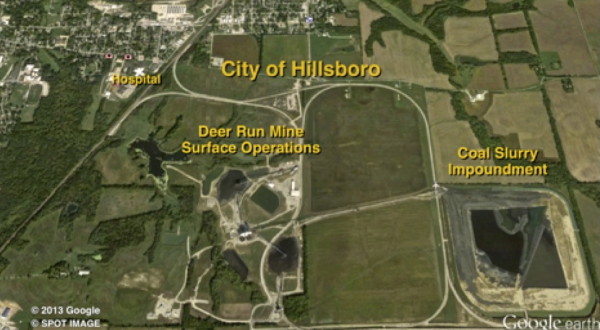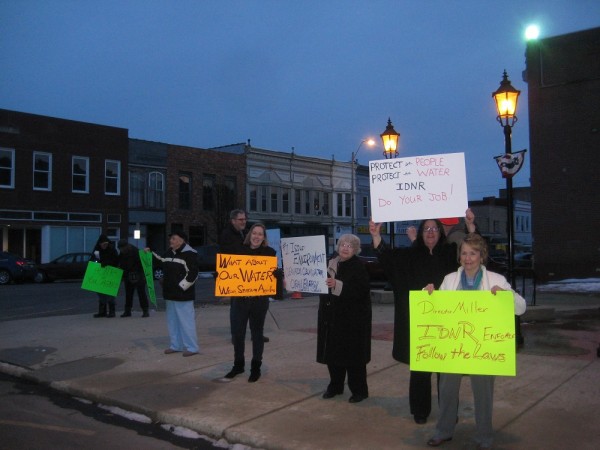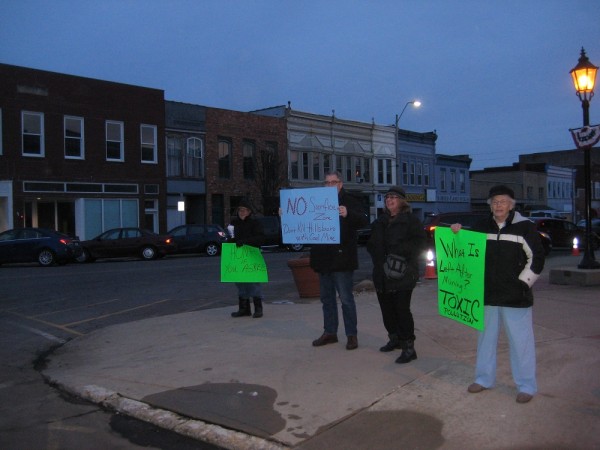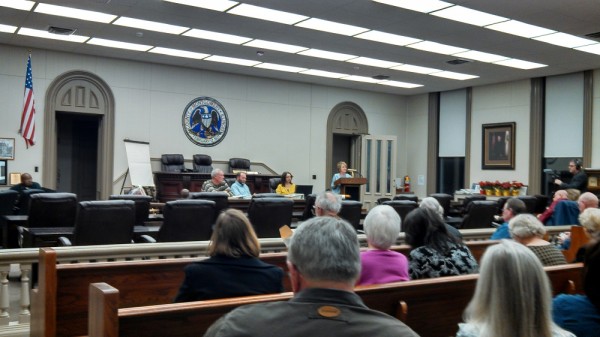 Permit 399 does not protect citizens and the environment from the impact of coal mining as state and federal mining laws intended. Specifically, Permit 399 does not provide adequate monitoring to show or establish that there is compliance with the Clean Air Act and the Clean Water Act.
Permit 399 does not protect citizens and the environment from the impact of coal mining as state and federal mining laws intended. Specifically, Permit 399 does not provide adequate monitoring to show or establish that there is compliance with the Clean Air Act and the Clean Water Act.
Permit 399 for Deer Run Mine should not be renewed for another 5 years. In fact, Permit 399 should never have been approved.
Illinois Department of Natural Resources Office of Mines and Minerals (IDNR/OMM) not only approved an incomplete permit, but also turned over the water and air quality to the Illinois Environmental Protection Agency (IEPA). When citizens expressed concerns about the impact of coal on their air, water, and community, IDNR/OMM responded that these issues were not in their purview. IDNR/OMM should be responsible for impacts from the mine as outlined in state and federal mining laws and that is not happening.
By turning over environmental responsibility of Deer Run Mine to IEPA, IDNR/OMM has essentially set up conditions that complicate and often hinder enforcement of mining laws. IDNR/OMM has granted Deer Run certain exemptions, which make the community even more vulnerable. Runoff from railroad loading zones and mine roadways are allowed to drain into the area surrounding the mine without any treatment. The most harmful components of coal are not monitored or analyzed so contamination of surface water like Central Park Creek is a threat. There is no monitoring of fugitive emissions that are unique to coal mining. There are no limitations in noise or time delays in road use due to rail transport. In short, Permit 399 does not reasonably protect citizens from the harmful effects of coal processing and transport in the community.
Deer Run Mine was granted a lifetime air permit with particulate matter limitations but it is not doing any monitoring. With the coal processing plant so close to the hospital and nursing home, the coal dust is potentially very harmful to residents. Many months ago, a petition signed by 364 citizens to have air monitors placed at the hospital and nursing home was presented to Mayor Downs. Hopefully, the citizens’ petition will be honored and air monitors will be established, possibly with Deer Run’s assistance; but, to date this has not happened.
When Roger Dennison (President of Hillsboro Energy, LLC) presented the positive aspects that coal mining will bring to Montgomery County at the Permit 399 hearing, he asked that we give the mine a chance to be a good neighbor. Well, the citizens of Montgomery County have given Deer Run Mine an excellent chance and they are still waiting for the good neighbor response from Deer Run.
In Tuesday’s (Feb. 18, 2014) Journal-News article on page 7B titled, “EPA Files Rules About Coke and Coal Piles,†the importance of dust suppression and enclosure of coal piles was given major emphasis. The damage to health resulting from fugitive coal dust should be a concern to all of us. For the record, a copy of the above news article was submitted into the record at the hearing.
 Perhaps the greatest threat to Hillsboro is the permanent existence of high-rise impoundments that can leak and fail over time. The non-impounding coal refuse area as presented in permit 399 was altered through revisions that did not allow for public involvement. The incised waste area was converted to a high-hazard 80-foot dam impoundment made of coarse coal waste. In doing this, IDNR/OMM was representing Hillsboro Energy LLC (HEL), not the interests of citizens in Montgomery County.
Perhaps the greatest threat to Hillsboro is the permanent existence of high-rise impoundments that can leak and fail over time. The non-impounding coal refuse area as presented in permit 399 was altered through revisions that did not allow for public involvement. The incised waste area was converted to a high-hazard 80-foot dam impoundment made of coarse coal waste. In doing this, IDNR/OMM was representing Hillsboro Energy LLC (HEL), not the interests of citizens in Montgomery County.
From a background perspective, it is important to point out that the location of the slurry waste area in Permit 399 was suggested by the Montgomery County Soil and Water Conversation District to be moved out of the Hillsboro Lake’s watershed. This agency also pointed out that the permit application failed to include all the intermittent streams within the permit and shadow areas and are therefore vulnerable to contamination and mine runoff. Montgomery County SWCD also questioned how the drainage and restoration of the longwall subsidence could be accomplished within one year as proposed.  The very pertinent Montgomery County SWCD letter dated March 24, 2008 to Mr. Scott Fowler was not discovered until November 6, 2012 through a FOIA request to the Montgomery County SWCD. This letter was not available for reviewing or found in the Permit 399 file. A copy of this letter was submitted for the record.
There are techniques that could be used to process coal that would not result in high hazard impoundments, but IDNR/OMM approves what the coal operator wants, not what is best for the community. HEL has applied for a 2nd impoundment that is twice the size as the first and closer to residents in Hillsboro and Schram City. Failure of this impoundment would inundate portions of Hillsboro and Schram City with tragic consequences.
IDNR/OMM intends to approve this high risk coal slurry impoundment even with the location creating a serious potential threat to residents.
Illinois is now experiencing what is called the West Virginia Syndrome–the production of coal with the coal operator shielded from its responsibility to the community. In Illinois, the government officials and regulatory agencies, similar to West Virginia, are beholden to coal. They can see the damage that coal has done to West Virginia citizens, but our officials seem immune to the reality. Chris Cline, owner of Deer Run, has established himself in West Virginia and identifies with Don Blankenship of Massey Energy as a talented coal leader. So far, the policies in Illinois have followed the same favoritism to coal as in West Virginia.
Before we have any more irreversible damage, IDNR/OMM must start enforcing mining laws with the protection of citizens in mind to prevent a repeat of the environmental disasters in Illinois that have already occurred in West Virginia.





